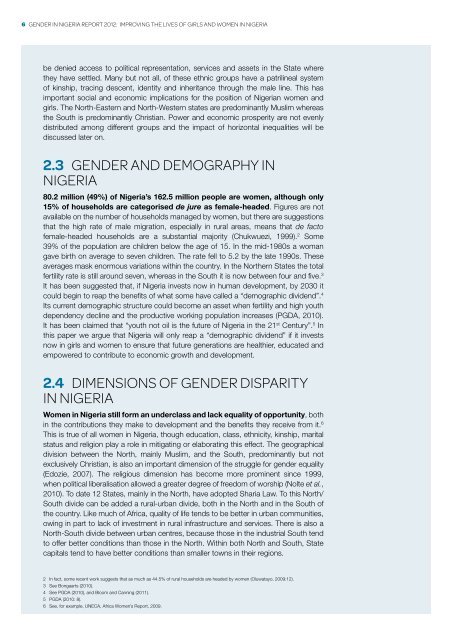Gender in niGeria report 2012 - Economic Commission for Africa
Gender in niGeria report 2012 - Economic Commission for Africa
Gender in niGeria report 2012 - Economic Commission for Africa
Create successful ePaper yourself
Turn your PDF publications into a flip-book with our unique Google optimized e-Paper software.
6 <strong>Gender</strong> <strong>in</strong> Nigeria Report <strong>2012</strong>: Improv<strong>in</strong>g the Lives of Girls and Women <strong>in</strong> Nigeria<br />
be denied access to political representation, services and assets <strong>in</strong> the State where<br />
they have settled. Many but not all, of these ethnic groups have a patril<strong>in</strong>eal system<br />
of k<strong>in</strong>ship, trac<strong>in</strong>g descent, identity and <strong>in</strong>heritance through the male l<strong>in</strong>e. This has<br />
important social and economic implications <strong>for</strong> the position of Nigerian women and<br />
girls. The North-Eastern and North-Western states are predom<strong>in</strong>antly Muslim whereas<br />
the South is predom<strong>in</strong>antly Christian. Power and economic prosperity are not evenly<br />
distributed among different groups and the impact of horizontal <strong>in</strong>equalities will be<br />
discussed later on.<br />
2.3 <strong>Gender</strong> and demography <strong>in</strong><br />
Nigeria<br />
80.2 million (49%) of Nigeria’s 162.5 million people are women, although only<br />
15% of households are categorised de jure as female-headed. Figures are not<br />
available on the number of households managed by women, but there are suggestions<br />
that the high rate of male migration, especially <strong>in</strong> rural areas, means that de facto<br />
female-headed households are a substantial majority (Chukwuezi, 1999). 2 Some<br />
39% of the population are children below the age of 15. In the mid-1980s a woman<br />
gave birth on average to seven children. The rate fell to 5.2 by the late 1990s. These<br />
averages mask enormous variations with<strong>in</strong> the country. In the Northern States the total<br />
fertility rate is still around seven, whereas <strong>in</strong> the South it is now between four and five. 3<br />
It has been suggested that, if Nigeria <strong>in</strong>vests now <strong>in</strong> human development, by 2030 it<br />
could beg<strong>in</strong> to reap the benefits of what some have called a “demographic dividend”. 4<br />
Its current demographic structure could become an asset when fertility and high youth<br />
dependency decl<strong>in</strong>e and the productive work<strong>in</strong>g population <strong>in</strong>creases (PGDA, 2010).<br />
It has been claimed that “youth not oil is the future of Nigeria <strong>in</strong> the 21 st Century”. 5 In<br />
this paper we argue that Nigeria will only reap a “demographic dividend” if it <strong>in</strong>vests<br />
now <strong>in</strong> girls and women to ensure that future generations are healthier, educated and<br />
empowered to contribute to economic growth and development.<br />
2.4 Dimensions of gender disparity<br />
<strong>in</strong> Nigeria<br />
Women <strong>in</strong> Nigeria still <strong>for</strong>m an underclass and lack equality of opportunity, both<br />
<strong>in</strong> the contributions they make to development and the benefits they receive from it. 6<br />
This is true of all women <strong>in</strong> Nigeria, though education, class, ethnicity, k<strong>in</strong>ship, marital<br />
status and religion play a role <strong>in</strong> mitigat<strong>in</strong>g or elaborat<strong>in</strong>g this effect. The geographical<br />
division between the North, ma<strong>in</strong>ly Muslim, and the South, predom<strong>in</strong>antly but not<br />
exclusively Christian, is also an important dimension of the struggle <strong>for</strong> gender equality<br />
(Edozie, 2007). The religious dimension has become more prom<strong>in</strong>ent s<strong>in</strong>ce 1999,<br />
when political liberalisation allowed a greater degree of freedom of worship (Nolte et al.,<br />
2010). To date 12 States, ma<strong>in</strong>ly <strong>in</strong> the North, have adopted Sharia Law. To this North/<br />
South divide can be added a rural-urban divide, both <strong>in</strong> the North and <strong>in</strong> the South of<br />
the country. Like much of <strong>Africa</strong>, quality of life tends to be better <strong>in</strong> urban communities,<br />
ow<strong>in</strong>g <strong>in</strong> part to lack of <strong>in</strong>vestment <strong>in</strong> rural <strong>in</strong>frastructure and services. There is also a<br />
North-South divide between urban centres, because those <strong>in</strong> the <strong>in</strong>dustrial South tend<br />
to offer better conditions than those <strong>in</strong> the North. With<strong>in</strong> both North and South, State<br />
capitals tend to have better conditions than smaller towns <strong>in</strong> their regions.<br />
2 In fact, some recent work suggests that as much as 44.5% of rural households are headed by women (Oluwatayo, 2009:12).<br />
3 See Bongaarts (2010).<br />
4 See PGDA (2010), and Bloom and Cann<strong>in</strong>g (2011).<br />
5 PGDA (2010: 8).<br />
6 See, <strong>for</strong> example, UNECA, <strong>Africa</strong> Women’s Report, 2009.

















